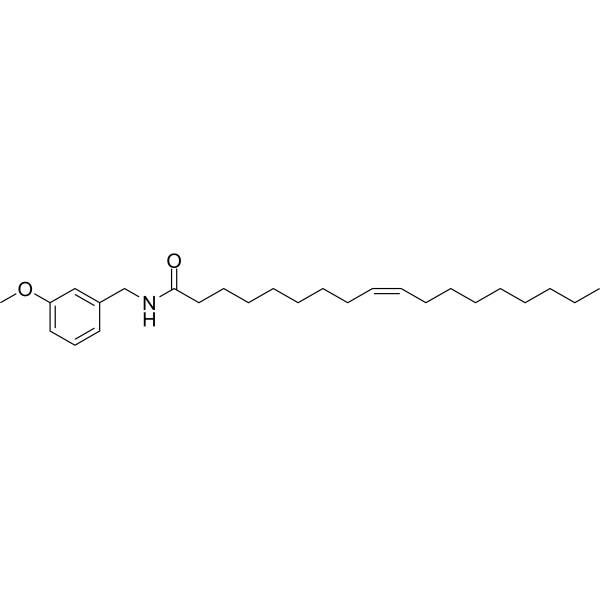
N-(3-Methoxybenzyl)oleamide
CAS No. 883715-21-7
N-(3-Methoxybenzyl)oleamide ( )
Catalog No. M31464 CAS No. 883715-21-7
N-(3-Methoxybenzyl)Oleamide, an agmatine isolated from Lepidium meyenii, has pharmacological effects on exercise-induced fatigue, which may be related to the modulation of energy metabolism and improvement of antioxidant status.
Purity : >98% (HPLC)
 COA
COA
 Datasheet
Datasheet
 HNMR
HNMR
 HPLC
HPLC
 MSDS
MSDS
 Handing Instructions
Handing Instructions
| Size | Price / USD | Stock | Quantity |
| 5MG | 88 | In Stock |


|
| 10MG | 133 | In Stock |


|
| 50MG | Get Quote | In Stock |


|
| 100MG | Get Quote | In Stock |


|
Biological Information
-
Product NameN-(3-Methoxybenzyl)oleamide
-
NoteResearch use only, not for human use.
-
Brief DescriptionN-(3-Methoxybenzyl)Oleamide, an agmatine isolated from Lepidium meyenii, has pharmacological effects on exercise-induced fatigue, which may be related to the modulation of energy metabolism and improvement of antioxidant status.
-
DescriptionN-(3-Methoxybenzyl)Oleamide, an agmatine isolated from Lepidium meyenii, has pharmacological effects on exercise-induced fatigue, which may be related to the modulation of energy metabolism and improvement of antioxidant status.
-
Synonyms
-
PathwayOthers
-
TargetOther Targets
-
Recptor——
-
Research Area——
-
Indication——
Chemical Information
-
CAS Number883715-21-7
-
Formula Weight401.6
-
Molecular FormulaC26H43NO2
-
Purity>98% (HPLC)
-
Solubility——
-
SMILES——
-
Chemical Name
Shipping & Storage Information
-
Storage(-20℃)
-
ShippingWith Ice Pack
-
Stability≥ 2 years
Reference
molnova catalog


related products
-
Nyasol
Nyasol may have potential to be developed as medicines for the treatment of allergies by inhibiting the activation of mast cells.
-
Thiamine nitrate
Thiamine nitrate is an essential vitamin, and can enhance normal neuronal actives.
-
Chiniofon
Chiniofon, a halogenated 8-hydroxyquinoline, is used as an antiamebic drug. This type of anti-amebic drug exerts an anti-amebic effect by inhibiting intestinal commensal bacteria and affects amoebic dysentery, but has no effect on extra-intestinal amoebic parasites.



 Cart
Cart
 sales@molnova.com
sales@molnova.com


